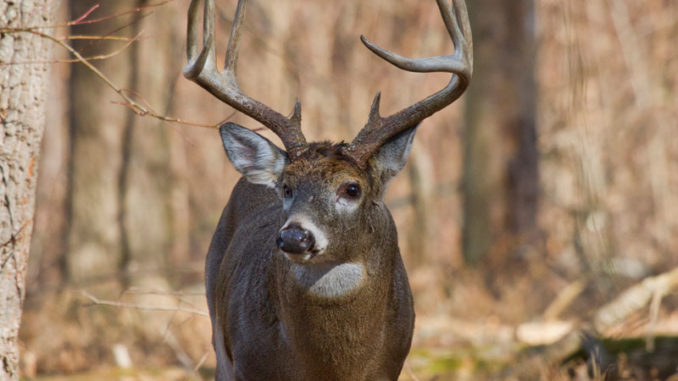
Low spots between high places are highways that deer frequently use.
Growing up in the piedmont, I was accustomed to hunting deer along creeks, rivers and around agriculture fields. When I moved to Greer, everything changed. The terrain in Game Zone 1, South Carolina’s Upstate, dictates different methods to consistently take nice bucks. Learning how to read the land and understanding how deer travel completely changed my approach.
While a good portion of the area is farm fields and rolling hills, the majority is mountainous. For South Carolina hunters wanting to maximize their opportunity, understanding that mountain deer do not necessarily behave differently is a key. It’s the terrain that dictates that hunters react differently to the conditions with which we are forced to work. Hunting deer in the mountains means that changing tactics to be successful harvesting big bucks.
For hunters not familiar with South Carolina’s mountains, it’s important to note that when traveling through these vast mature forests, a thorough knowledge of an area is imperative. A working knowledge of a good GPS unit is a great idea. I learned early on that one ridge looks like another ridge, and all of the foliage and trees seem to make knowing where one is a bit more difficult. I can say that while I haven’t been lost in the mountains, I was a bit confused for about seven hours once. That experience alone taught me that hunting in the mountains is a different ball game.
Approaching a ridge during the early dawn in the vast mountain unit can be intimidating. This unit alone consists of 152,575 acres in Oconee, Pickens and Greenville counties, including a lot of public land and many different WMAs, plus the Sumter National Forest. Some of the most-remote areas also hold the best deer hunting. Arguably, the best hunting is in the Jocassee Gorges in Oconee County and the Watson-Cooper Heritage Preserve above Caesars Head State Park in Pickens County. While there are many others that have outstanding deer hunting, these stand out for big woods and little hunting pressure.
When hunting terrain with steep ridges and deep draws, understanding how deer travel will put more bucks in your sights. The mountains are full of oaks of various varieties, and with native browse and acorns being the bread and butter for deer, finding the acorns that are falling will put you in a prime location.
Finding an oak ridge that has a well-defined saddle will increase your odds exponentially. Bucks in mountainous areas will walk through saddles 100 percent of the time, so setting up a stand in a saddle close to a good food source is where it begins.
Deciding where to focus begins with a good study of maps. Topographical maps are readily available from the U.S. Geological Society, and from online sources such as www.mytopo.com; these resources will help identify road access, parking areas, ridges, saddles, streams and access routes to stands. The S.C. Department of Natural Resources also provides maps free of charge or online at http://www.dnr.sc.gov/wma/maps.html. Without a good topographical map, a lot more boot leather is required to find the best areas to hunt. Using these maps will help identify specific areas to target for scouting and for hunting. Once identified, scouting these saddles will help to identify the best locations for stands.
A map study will show where bucks travel. A saddle is a low area between two ridges or higher points of elevation. When a buck wants to move from one side of a ridge to another, he will almost always use a saddle.
Kip Adams, a biologist with the Quality Deer Management Association, grew up hunting the mountains of his native Pennsylvania and understands how much a saddle means.
“Mountain deer are mountain deer, and they behave the same regardless of where in the country you are in,” he said. “Given a choice, I will hunt a saddle over every other option out there.”
Adams explained that deer in general, and big bucks specifically, do not like to expose themselves, so they will travel through areas that provide the most cover. Walking through a saddle allows them to remain mostly hidden while still being able to see and smell relatively well.
“After I have identified a saddle, I look for other terrain features in and around that saddle that may affect the deer traveling through it,” he said. “When I identify those features, that is where I want to hang my stand.”
In areas where mountain laurel is present, this can be especially true. The mountain laurel present in South Carolina’s mountains provides excellent cover for bucks traveling during daylight hours.
“If I see a stand of laurel adjacent to the saddle, I want to sit as close to it as I can to try and pick up deer moving though that laurel.” Adams said.
The difficult part of the game is first finding a saddle, and then finding the right saddle. Saddles can be as narrow as 30 yards or as wide as several hundred. When hunting wider saddles, consider setting up not necessarily in the middle, but as Adams said, closer to the other features that may concentrate deer movement. For example, if the saddle is subtle on one side of the ridge, and the opposite side has a steep drop, the deer will hug the ridge when crossing the saddle, in this scenario you would want to sit closer to the ridge instead of the middle. .
I had scouted and found a great location that was covered with large white oak acorns. Carefully marking the trail, I waited for a good northwest wind before entering in the predawn hours. Knowing I had a good mile-and-a-half walk into the mountains, I parked the truck three hours before first light. Carrying my portable climbing stand on my back, I trekked into the mountain darkness, following an old logging road that meandered most of the way, then veering off the road and into the woods.
Turning on my GPS took the confusion out of the darkness. I followed the markings to the tree I selected several months earlier. I climbed up and settled in for the wait. As the night gave way to the morning, the light showed deer already feeding on the large acorns that littered the ground. I sat along the southern edge of the saddle, allowing the breeze to filter into my face, hoping the deer would feed from the ridge in front of me. As luck held, the deer moved along the northern side of the ridge. Cold mornings in the mountains force deer to concentrate along south-facing slopes to catch the warmth of the first rays of the morning sun. With a high ridge behind me and another in front, I was confident deer would move in front of my stand. As the morning wore on, deer after deer moved through the saddle from the northern side to the southern side, feeding as they moved. The sun’s rays glistened off of an antler in the distance as a buck headed my way. This particular saddle was at least 100 yards wide, and he fed through at 50 yards. I had my bow ready all the time, but he never gave me a shot in my comfort range. Still, the saddle had proved its worth. I sat the rest of the morning watching as several does passed within range, but I’d elected not to shoot in hopes the buck would return.
Hunting deer in the mountains is a different in any aspects to hunting in the piedmont or along the coastal zones. Certainly deer are deer, but in the hills and hollers of South Carolina’s mountains, you have to saddle up to consistently find big bucks.




Be the first to comment